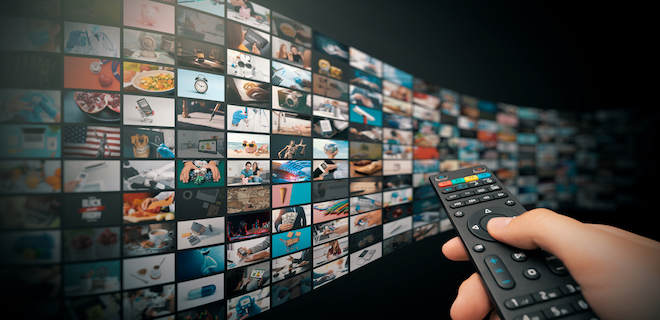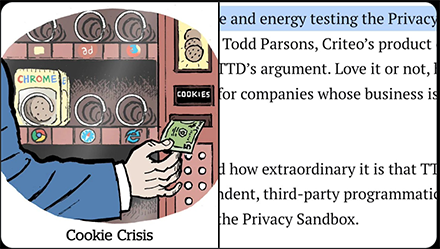 |
||||||||||||||
|
||||||||||||||
| The Unnamed Streaming Subscription Tiers |

Image sourced from Shutterstock
|
The pandemic lockdowns were heady days for streaming services and represented a bright economic spot. With little opportunity to entertain themselves, consumers splurged on subscriptions, binge-watching shows like nobody’s business. But as society opened up, consumers canceled those subscriptions en masse. Providers have been searching for a workable business model ever since. Take Amazon. For years, Amazon Prime users had two ad-free options for watching video content: transactional video on demand (TVOD) and subscription video on demand (SVOD). The first option allowed people to purchase or rent a movie or TV show; the second was to consume any of the Amazon Prime library. In late December, Amazon announced that paying customers who want to continue that same ad-free viewing experience must cough up an extra $2.99. The company promises viewers will see fewer ads than on other AVOD services, which typically air anywhere from six to eight minutes of ads per hour. I call this move AVOD Lite, a tier between AVOD and SVOD. Amazon isn’t alone. All streaming companies are raising their subscription rates. As The Verge states, “The move comes as competing streaming services continue to raise subscription rates across the board and push ads upon customers on their cheapest monthly plans.” Of course, at $14.99 a month, Amazon Prime isn’t a cheap AVOD service. The Balkanization of Streaming TV But raising rates isn’t the only driver behind higher TV costs. Brands have balkanized the streaming landscape, and all the additional fees one pays to watch a show everyone talks about add up. I don’t watch much TV, but I like the show The Gilded Age, which is available on Max. I pay $15.99 a month to Max for the express purpose of watching that show, although I have watched one or two home design renovation shows. According to CableTV.com, Amazon Prime provides access to the widest array of content, and sure enough, I can watch The Gilded Age via Prime. Still, I need to purchase individual episodes for $2.99 a pop or subscribe to HBO Max through Prime for an additional $14.99 monthly cost. It’s just not worth it. I call this Balkanization SVOD Plus, a tier between TVOD and SVOD. If Amazon shows ads in those episodes, it will also contain a touch of AVOD. YouTube TV offers access to over 100 YouTube channels, but the $72.99 is more than I want to pay. That’s the cost of cable, but there’s a reason why cord-cutting is a thing. Subscription Hopping I’m not alone in subscribing to a streaming service to watch one show, but I am probably unique in maintaining the subscription throughout the year. According to a survey released earlier this year, 57% of consumers also purchase subscriptions to watch a single show, but they binge-watch it and cancel after the first month. It’s a behavior I call subscription hopping. (Full disclosure: I subscribed to Disney Plus for one month to get my fix of Hamilton and then canceled. My older sister did the same, who watched it five times before canceling. But at $13.99 a month, that’s akin to the cost of a movie ticket. It’s easy to see why this is an attractive route for people.) Meanwhile, streaming companies are raising rates and slashing the number of new scripted shows they order. About a year ago, we began seeing stories predicting the decline of peak TV, but Ampere Analysis bears it out. New shows fell by 24% in the second half of 2023 compared to H2 2022. Granted, the cutback in new content could be due to the five-month writer’s strike, but the stories of peak TV’s decline predated it. |
| Since 57% of consumers are subscription hoppers, is cutting back on new content a wise idea? Other 2023 studies show that one in three viewers canceled subscriptions to cut back on monthly expenses, and 36.7% because they found they weren’t watching enough to justify the monthly expense. The latter doesn’t bode well for companies seeking to offer a slimmer slate of content. Amazon’s letter to its Prime subscribers said that $2.99 for ad-free service will help fund better content. “This will allow us to continue investing in compelling content and keep increasing that investment over a long period of time.” Amazon has an advantage in that a Prime subscription comes with many other advantages, such as free product shipping. The streaming service upended Hollywood, but its business model isn’t quite there yet, as consumers are finding new ways to pay as little as possible and see as few ads as possible. Meanwhile, advertisers are counting on CTV to reach and engage the consumer. One thing is for sure: 2024 will be an interesting year. |
|
| FTC Click-To-Cancel Rule Virtual Hearing |
| On January 16, 2024, The FTC will hold an informal -- and "casual" hearing to discuss the "click-to-cancel" provision (aka the Negative Option Rule) announced in March 2023. The purpose of the rule is to make it as easy for consumers to cancel as it is to sign up for recurring subscriptions. According to the FTC, the purpose of this rule is to "proposed changes are calculated to combat unfair or deceptive business practices, including recurring charges for products or services consumers do not want and cannot cancel without undue difficulty." The FTC is aiming the "click to subscribe/call the cancel" workflows deployed by lots of internet-based services. Many publishers object to the provision, saying it will create headaches for customer care teams who subscribers will call when they accidentally cancel service. Besides, the News/Media Alliance argues that publishers are rarely criticized for arduous cancellation policies. |
| Google Agrees To Pay $700 Million in Settlement, but Many Say It’s Not Enough |
| On December 11, 2023, a jury found Google violated antitrust laws by unfairly stifling competition against Epic Games within Google Play. Simultaneously, all 50 State Attorneys General had similar suits pending, but a new agreement will settle all of them in one fell swoop. To many, it's a minor slap on the wrist. The Verge notes that $700 million represents just 21 days of operating profit in the Google Play app store. More importantly, the settlement puts time limits on Google's behavior. For instance, Google must allow third-party app stores on Android devices for seven years. Consumers who overpay for apps should receive compensation, as $630 of that settlement is slated for them. |
| Let the Publisher Generative AI Backlash Begin |
| While we have definitely been ones to report on the benefits of generative AI for the news industry, we haven’t discussed the implications of the latest tech du jour without its caveats. One of the main issues we have been hearing from publishers in developing generative AI is copyright infringement. But now, The New York Times is taking OpenAI and Microsoft to court. The battle has been long and arduous over nine months with no resolve, and now The New York Times is out for blood. Well, not literally, but the publisher accused ChatGPT and Microsoft of “seeking a free ride” on its own “massive investment” in original journalism. Sounds a little like the battle between news publishers and the duopoly (cough, cough). This case points to what Noah Feldman calls “a classic instance of the lag between established law and emerging technology.” The news comes just weeks after Axel Springer announced a partnership with OpenAI to “enrich users’ experience with ChatGPT by adding recent and authoritative content on a wide variety of topics, and explicitly values the publisher’s role in contributing to OpenAI’s products” — we’re certain that more publishers will follow the Times lead until there are definitive laws about how these things should work documented in the books. |
| Google Ads Team Shake-Up? |
| In the era of AI, even Google’s ads team is impacted. In case you missed the news while you were out on holiday, Google’s ad sales team is reportedly reshuffling its 30,000-person ad sales unit, likely in response to the AI automation boom. The Information reported the news after learning that the President of the Americas and global partners at Google, Sean Downey, announced the restructuring plans during a department-wide meeting. This could be a sign that the tech giant plans to leverage AI for more targeted and efficient placement of ads. After massive layoffs at the company earlier this year, the big question is, what’s happening to those 30,000 people? |












